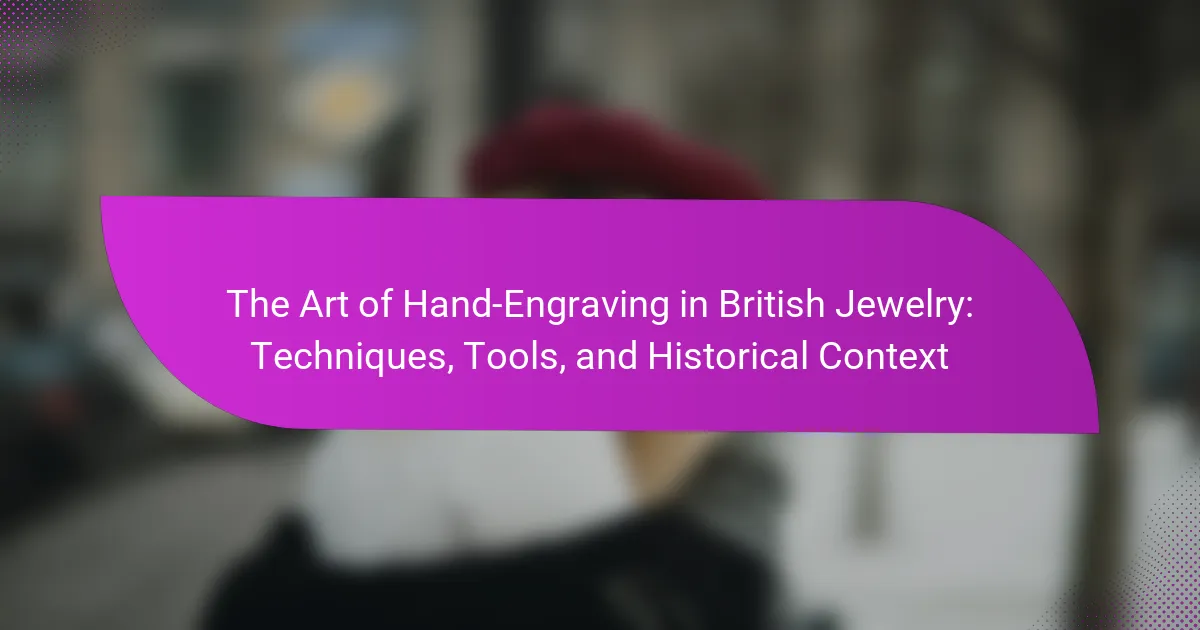Hand-engraving is a traditional technique in British jewelry that involves using a burin to create intricate designs on metal surfaces. This method allows for customization and personalization, resulting in unique, one-of-a-kind pieces that reflect the skill and artistry of the artisan. Essential tools for hand-engraving include gravers, a bench block, and a magnifying glass, which facilitate precision and detail in the engraving process. Contemporary applications of this technique encompass personalization, intricate design creation, and the restoration of antique jewelry, blending traditional craftsmanship with modern aesthetics to meet current market demands. The significance of hand-engraving in British jewelry highlights its historical context and enduring value in contemporary craftsmanship.

What is Hand-Engraving in British Jewelry?
Hand-engraving in British jewelry is a traditional technique used to create intricate designs on metal surfaces. This method involves using a specialized tool called a burin to carve detailed patterns and images. Hand-engraving allows for customization and personalization of jewelry pieces. It has historical significance in British craftsmanship, dating back centuries. The technique emphasizes skill and artistry, often resulting in unique, one-of-a-kind items. Artisans typically employ various styles, including floral, geometric, and narrative designs. The precision of hand-engraving distinguishes it from machine methods, enhancing the value of the jewelry. This craftsmanship remains highly regarded in contemporary jewelry making.
How did hand-engraving evolve in British jewelry?
Hand-engraving in British jewelry evolved significantly from the medieval period to the present day. Initially, engravers utilized simple tools to create basic designs on metal surfaces. By the 16th century, more intricate techniques emerged, influenced by the Renaissance’s artistic advancements. The introduction of the burin allowed for finer detailing and greater precision.
In the 18th century, hand-engraving became a hallmark of British craftsmanship, with artisans producing elaborate patterns and motifs. The Victorian era saw a surge in popularity for personalized jewelry, further driving the demand for skilled engravers.
The Industrial Revolution introduced mechanization, yet traditional hand-engraving remained valued for its uniqueness. Today, hand-engraving continues to thrive alongside modern techniques, preserving its historical significance in British jewelry.
What historical influences shaped the techniques used in hand-engraving?
The techniques used in hand-engraving have been shaped by various historical influences. Early engravers in ancient civilizations, such as Egypt and Mesopotamia, laid foundational techniques. Their methods focused on creating intricate designs on metal and stone. The Renaissance period saw a revival of classical art, enhancing engraving techniques with greater precision and detail. Innovations in tools, such as the burin, emerged during this time, allowing for more complex patterns. The Industrial Revolution introduced mechanization, which influenced hand-engraving by increasing accessibility to tools. Additionally, cultural exchanges through trade brought diverse styles and techniques to British engravers. These historical contexts collectively shaped the evolution of hand-engraving techniques in jewelry-making.
How has the perception of hand-engraving changed over time?
The perception of hand-engraving has evolved significantly over time. Initially, hand-engraving was viewed as a prestigious and highly skilled art form. It was essential in creating intricate designs on jewelry and other decorative items. In the Victorian era, hand-engraving was particularly celebrated for its craftsmanship and attention to detail.
However, with the advent of industrialization and machine engraving, the perception shifted. Hand-engraving began to be seen as less relevant in the mass production era. Many consumers favored the efficiency and lower costs of machine-made items.
In recent years, there has been a resurgence of interest in hand-engraving. This revival is partly due to a growing appreciation for artisanal skills and unique craftsmanship. Modern consumers value the individuality and personal touch that hand-engraved pieces offer.
Today, hand-engraving is often regarded as a luxury art form. It is associated with bespoke jewelry and personalized gifts. This shift reflects a broader trend towards valuing handmade and unique items in a world dominated by mass production.
What are the key characteristics of hand-engraving?
Hand-engraving is a meticulous art form characterized by its precision and craftsmanship. It involves the manual carving of designs into various materials, primarily metal. The technique requires specialized tools, such as gravers and burins, which allow for detailed work. Hand-engraving produces unique textures and intricate patterns that are often not replicable by machines. The process is time-consuming, emphasizing the artisan’s skill and attention to detail. Historically, hand-engraving has been used in jewelry making to create personalized items and ornate designs. This traditional method remains valued for its aesthetic appeal and the individuality it imparts to each piece.
What techniques define hand-engraving in British jewelry?
Techniques that define hand-engraving in British jewelry include the use of burins, stippling, and bright-cut engraving. Burins are specialized tools that create precise lines and designs. Stippling involves creating texture through small dots or marks. Bright-cut engraving is characterized by removing metal to create shiny, reflective surfaces. Each technique showcases the skill and artistry of the engraver. Historical records indicate that these methods have been used for centuries in British jewelry making. The combination of these techniques allows for intricate designs that enhance the aesthetic appeal of the jewelry.
How does hand-engraving differ from other jewelry-making techniques?
Hand-engraving differs from other jewelry-making techniques by its reliance on manual skill to create intricate designs directly onto metal surfaces. This technique allows for personalized and detailed artistry that cannot be easily replicated by machines. Unlike casting or stamping, which involve creating shapes from molds, hand-engraving requires precision and a steady hand to carve patterns. It is often used to add unique elements such as initials or intricate motifs. Historical records show that hand-engraving has been practiced for centuries, making it a traditional art form in jewelry making. This technique offers a tactile quality and depth that machine-made alternatives lack.

What tools are essential for hand-engraving?
Essential tools for hand-engraving include gravers, a bench block, and a magnifying glass. Gravels are specialized tools used for cutting and carving designs into metal. A bench block provides a sturdy surface for engraving work. A magnifying glass aids in precision and detail during the engraving process. Other important tools are a scribe for marking designs, a burnisher for polishing, and various files for finishing touches. These tools are critical for achieving high-quality results in hand-engraving.
What types of tools are used in hand-engraving?
Hand-engraving utilizes various specialized tools. Common tools include gravers, which are pointed instruments used to carve designs into metal. Burins, featuring a chisel-like edge, allow for precise line work. Other essential tools are the hammer and the anvil, which provide support and force during engraving. Additionally, a microscope may be used for detailed work on small areas. Engraving blocks help stabilize the metal piece being worked on. These tools collectively enable artisans to create intricate designs in jewelry. Their effectiveness has been recognized throughout history in the craftsmanship of British jewelry.
How do different tools affect the engraving process?
Different tools significantly influence the engraving process. Each tool provides distinct capabilities, affecting precision, depth, and detail. For example, a burin allows for fine lines and intricate designs. In contrast, a chisel is suitable for broader strokes and deeper cuts. The material of the tool also matters; hardened steel tools maintain sharpness longer than softer materials. Additionally, the size and shape of the tool impact the overall design. Larger tools can create wider areas of texture, while smaller tools allow for delicate work. Historical practices show that artisans often selected tools based on the specific requirements of the piece they were creating. Thus, the choice of tool directly affects the quality and style of the final engraving.
What is the significance of tool selection in achieving quality engravings?
Tool selection is crucial for achieving quality engravings. The right tools ensure precision and control during the engraving process. Different tools produce varied line widths and depths. For example, a burin allows for fine details, while a chisel can create broader strokes. Quality tools also reduce the risk of mistakes and damage to the material. Using appropriate tools can enhance the overall aesthetic of the engraving. Additionally, the material being engraved often dictates the tool choice. Harder materials require specific tools to achieve desired effects. Therefore, thoughtful tool selection directly influences the quality and artistry of engravings.
How do engravers maintain and care for their tools?
Engravers maintain and care for their tools through regular cleaning, sharpening, and proper storage. Cleaning involves removing debris and residue after each use. This prevents buildup that can damage the tools. Engravers sharpen their tools using specialized sharpening stones or files. Regular sharpening ensures precision and efficiency in engraving. Proper storage in a dry, organized space protects tools from rust and damage. Some engravers use protective cases or wraps to keep tools secure. Regular maintenance extends the life of engraving tools and improves performance. This practice is essential for achieving high-quality results in engraving work.
What are best practices for tool maintenance?
Regular cleaning is essential for tool maintenance. Clean tools after each use to remove debris and prevent rust. Use appropriate cleaning solutions based on the tool material. Lubricate moving parts to ensure smooth operation and reduce wear. Inspect tools for damage or wear regularly. Replace worn or damaged parts promptly to maintain performance. Store tools in a dry, secure environment to prevent corrosion. Follow manufacturer guidelines for specific tools to ensure longevity. Proper maintenance extends the life of tools and enhances engraving quality.
How does tool care impact the quality of hand-engraving?
Tool care significantly impacts the quality of hand-engraving. Properly maintained tools ensure precision and consistency during the engraving process. Dull or damaged tools can lead to uneven lines and poor detail. Regular sharpening and cleaning remove debris that can affect the engraving quality. Additionally, using the right lubricant prevents overheating and prolongs tool life. High-quality tools, when cared for, yield finer results and enhance the overall craftsmanship. Research indicates that tool maintenance directly correlates with improved engraving outcomes, emphasizing the importance of this practice in hand-engraving.

What are the contemporary applications of hand-engraving in British jewelry?
Contemporary applications of hand-engraving in British jewelry include personalization, intricate designs, and restoration. Jewelry designers utilize hand-engraving to create unique pieces tailored to individual customers. This technique allows for the addition of names, dates, or personal messages, enhancing sentimental value. Additionally, hand-engraving is employed to produce detailed patterns and textures, adding depth to jewelry. The method is also used in the restoration of antique pieces, preserving their original artistry. British jewelers often blend traditional hand-engraving with modern techniques, creating hybrid styles that appeal to contemporary tastes. This practice maintains the heritage of craftsmanship while meeting current market demands.
How is hand-engraving being integrated into modern jewelry design?
Hand-engraving is increasingly integrated into modern jewelry design through personalized and intricate detailing. Designers use hand-engraving to create unique patterns and textures that enhance the aesthetic appeal of pieces. This technique allows for customization, enabling clients to add initials or special dates to their jewelry. The resurgence of artisan craftsmanship has led to a growing appreciation for hand-engraved items. Many contemporary jewelers now incorporate traditional hand-engraving alongside modern techniques, blending old and new styles. This combination results in distinctive pieces that tell a personal story. Furthermore, the tactile quality of hand-engraving adds depth and character to jewelry, setting it apart from mass-produced items. The integration of hand-engraving reflects a broader trend towards individuality in fashion and accessories.
What trends are emerging in the use of hand-engraving today?
Emerging trends in hand-engraving today include a revival of traditional techniques and the integration of modern technology. Artisans are increasingly blending hand-engraving with laser engraving for precision. There is a growing demand for personalized and bespoke jewelry, enhancing the appeal of hand-engraved pieces. Eco-conscious consumers are favoring sustainable materials in engraved jewelry. Social media platforms are showcasing unique designs, boosting visibility for hand-engravers. Collaborative projects between engravers and other artisans are also on the rise. This resurgence reflects a broader appreciation for craftsmanship and individuality in jewelry design.
How do contemporary jewelers honor traditional techniques?
Contemporary jewelers honor traditional techniques by incorporating hand-engraving methods into their designs. They often use tools like burins and gravers, which have been utilized for centuries. This practice connects modern creations with historical craftsmanship. Many jewelers study historical pieces to understand techniques and styles. Some even undergo apprenticeships with master engravers to learn these skills firsthand. By blending old and new methods, they create unique pieces that reflect both innovation and tradition. This approach preserves the heritage of jewelry-making while appealing to contemporary tastes.
What challenges do hand-engravers face in the modern market?
Hand-engravers face significant challenges in the modern market. One major challenge is competition from machine engraving. This technology offers faster production and lower costs. As a result, many consumers prefer machine-engraved items. Another challenge is the decline in demand for bespoke jewelry. Many customers now favor mass-produced alternatives. Additionally, hand-engravers often struggle with the high cost of materials. This affects their pricing and profitability. Moreover, there is a lack of awareness about the value of hand-engraving. Many potential clients do not understand its uniqueness and craftsmanship. Finally, hand-engravers face difficulties in marketing their skills effectively. This limits their reach to potential customers.
How does technology impact traditional hand-engraving practices?
Technology significantly impacts traditional hand-engraving practices by introducing new tools and methods. Laser engraving machines allow for precision that hand-engraving cannot achieve. These machines can replicate intricate designs quickly and consistently. Digital design software enables engravers to visualize and modify designs before production. This reduces the time spent on trial and error in the engraving process. Additionally, technology has expanded the range of materials that can be engraved. For example, modern tools can engrave on metals, glass, and even wood with ease. While traditional techniques emphasize craftsmanship, technology enhances efficiency and accessibility in engraving. The integration of technology has led to a shift in skill requirements for engravers. Many now need to be proficient in digital tools alongside traditional skills.
What strategies can engravers use to overcome market challenges?
Engravers can use several strategies to overcome market challenges. Diversifying their services can attract a wider customer base. Offering personalized designs can enhance customer engagement. Collaborating with other artisans can create unique products and expand reach. Utilizing social media for marketing can increase visibility and attract new clients. Staying updated with industry trends can help engravers remain competitive. Investing in high-quality tools can improve efficiency and output quality. Engaging in local craft fairs can showcase their work directly to potential customers. Networking within the jewelry community can lead to referrals and partnerships.
What tips can be applied for aspiring hand-engravers?
Aspiring hand-engravers should practice consistently to develop their skills. Regular practice helps refine techniques and improves precision. They should invest in quality tools to ensure better results. High-quality tools can enhance the engraving process and reduce frustration. Learning from experienced engravers is beneficial. Mentorship provides valuable insights and tips. Studying different engraving styles broadens understanding and creativity. Exposure to various techniques can inspire unique designs. Maintaining a clean workspace is essential for safety and efficiency. A tidy environment promotes focus and reduces mistakes. Lastly, patience is crucial in the engraving process. Mastery takes time and dedication, and rushing can lead to errors.
What foundational skills are essential for beginners in hand-engraving?
Essential foundational skills for beginners in hand-engraving include precision, control, and an understanding of design. Precision is crucial for creating detailed and accurate engravings. Control over tools allows for varied depth and line quality. Understanding design principles helps in planning engravings effectively. Additionally, beginners should develop a steady hand to maintain consistency. Familiarity with different engraving tools is also important. Mastery of these skills lays the groundwork for more advanced techniques in hand-engraving.
How can aspiring engravers develop their unique style?
Aspiring engravers can develop their unique style by experimenting with various techniques and tools. They should practice different engraving methods, such as line work, shading, and texturing. Each technique offers distinct visual outcomes that can influence their personal style. Engravers should also study historical styles and contemporary trends for inspiration. Analyzing the work of established engravers helps identify elements they admire. Additionally, creating a portfolio of original designs fosters creativity and self-expression. Engravers can also participate in workshops and seek feedback from peers to refine their skills. Regular practice and a willingness to learn from mistakes are crucial for growth. Ultimately, developing a unique style is a continuous process of exploration and adaptation.
The main entity of this article is hand-engraving in British jewelry, a traditional technique that involves creating intricate designs on metal surfaces using specialized tools like burins. The article provides a comprehensive overview of the evolution of hand-engraving, its historical influences, and the key characteristics that define this meticulous craft. It discusses various engraving techniques, essential tools, and the significance of tool maintenance in achieving quality results. Additionally, the article explores contemporary applications of hand-engraving, emerging trends, and the challenges faced by modern engravers, offering valuable insights for aspiring artisans.
